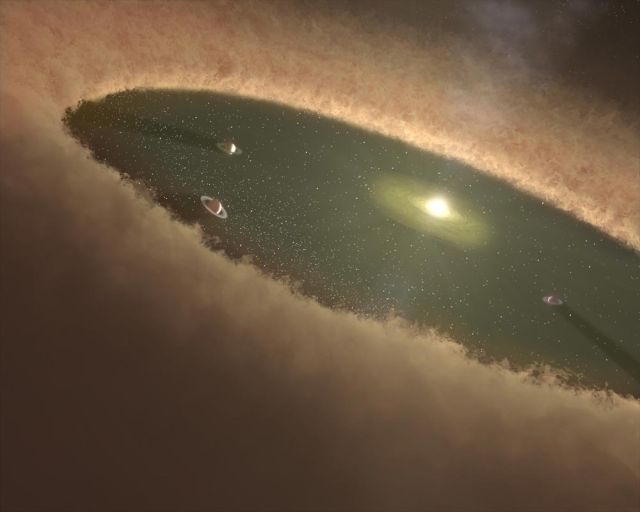First images of a planet in the act of forming
Hydrogen-alpha light is a dead giveaway that the planet is still growing.First images

An artist's conception of the still-growing exosolar system.
NASA/JPL-Caltech
Planets in general are pretty hard to observe, and forming planets are even harder. Normally, dips in the light of a star indicate to researchers that there’s a planet orbiting it. But that technique doesn’t work in young exosolar systems where the planets are still forming. Young stars, having recently finished forming themselves, are typically pretty chaotic, with their light output varying. And it’s nigh-impossible to tell the difference between these natural variations in a star’s light and a dip caused by a transiting planet.
Fortunately, a forming planetary system has its own observational advantages: the planets are putting out a lot of energy in the form of light. They're especially bright in hydrogen-alpha emissions, a particular shade of red that is very often useful in astronomy because it’s strongly emitted where hydrogen gas is ionized. It’s thought that the region around a still-forming planet can become hot enough to cause the hydrogen atoms to emit hydrogen-alpha light.
Using this light, researchers have created an actual photograph (a composite of hydrogen-alpha light and a few other
Researchers have been observing these planets for the past few years,
Also, the amount by which the planet’s magnetic field has eaten into the circumstellar disk gives an estimate on the strength of the magnetic field. It must be at least 20 times the present-day magnetic field of Jupiter. In gas giants like Jupiter and LkCa 15b, the magnetic field is controlled by the churning inner structure of the planet. So measuring the magnetic field provides an indirect glimpse at what’s going on inside the forming planet.
The researchers’ technique—looking for the hydrogen-alpha signature of a forming planet—is not exactly new. The same basic idea has been used to observe hydrogen-alpha light coming from a forming star. But
That, in turn, will provide more detailed understandings of how exosolar systems grow and become mature like our own
No comments:
Post a Comment